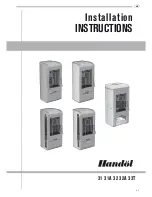
Chimneys and Venting
3.0 Chimney Characteristics and Components
3.1 DRAFT
Draft is widely misunderstood. It is important that you, the stove operator, realize that draft is a variable effect, not a given quantity.
Stoves and chimneys do not have draft, yet draft is the key to your stove’s performance.
Draft is a force, produced by an operating stove and the chimney to which it is attached. It is created by hot gases rising up the
chimney, creating a pressure difference between the inside of your home and the outside air. It continually moves fresh combustion air
into the stove, and hot exhaust gases out of the stove; without this constant flow, the fire will go out.
Other factors, such as barometric pressure, winds, the airtight nature of the home, the total inside chimney volume, chimney height and
the presence of venting devices such as exhaust fans also play a role in maintaining an adequate draft. In some cases, a window may
need to be left open, or some other source of fresh air provided, to keep the appliance operating properly. Low barometric pressures,
super insulated homes and exhaust fans can reduce draft; winds can play havoc with draft; and too large or too small a chimney volume
can cause reduced draft due to the excessive cooling or not enough room to vent exhaust gases quickly.
Some signs of inadequate draft are smoking, odor, difficulty in maintaining the fire, and low heat output. Overdraft can be caused by a
very tall chimney even if it is the recommended size, and can cause over firing of your stove. Signs of an overdraft include rapid fuel
consumption, inability to slow the fire, and parts of the stove or chimney connector glowing red. It is important that you follow the
chimney guidelines in this manual, including size, type, and height to avoid draft problems.
When installed and operated according to this manual, the this unit will produce enough hot gases to keep the chimney warm so that
adequate draft is maintained throughout the burn cycle. See later in this section for installation of a barometric damper to limit
maximum draft.
When solid fuels are burned completely, they produce water and carbon dioxide. However, in long slow burns, a substantial amount of
carbon monoxide may be produced. If allowed to build up, carbon monoxide (which is odorless) can prove fatally poisonous. Proper
ventilation and draft will prevent this from happening. If you smell smoke, thoroughly ventilate your dwelling, and contact your dealer
for service. Retest the draft and properly set the barometric damper. Other causes of poor ventilation or draft are icing, exhaust fans, a
blocked outside air inlet, and room air starvation. If your stove is sluggish and you get occasional odor, check these possibilities and
increase the airflow in your home.
3.2 CHIMNEY CONNECTORS
In general, following these guidelines will ensure compliance with all national and provincial codes; prior to beginning your
installation, check with your local building code official to check on additional local regulations which may influence the design and
placement of your venting system.
The Legacy Super Magnum Coal Stoker may be installed with 24 MSG, 6 inch diameter (150mm) chimney connector pipe. Size of the
connector should correspond to the size of the flue collar opening. Do not use makeshift compromises. No part of the chimney
connector may pass through an attic or roof space, closet or other concealed space, or through a floor or ceiling. Whenever possible,
avoid passing the connector through a combustible wall; if you must, use an approved wall pass-through, described later in this section.
Assemble the connector beginning at the flue collar, with the crimped ends pointing towards the stove (to keep debris and creosote
flakes inside the system). Each joint, including the one to the stove’s flue collar and the one to the chimney itself should be secured with
at least three sheet metal screws. Screws may be a maximum of 3 inches apart. A 1-1/4" (30 mm) overlap is required at each joint,
including the flue collar attachment. No more than two 90 degree elbows should be used, and the total length of connector should not
exceed 10 feet (3 m). All horizontal runs of connector must have a minimum upward slope of 1/4"(6 mm) per foot (20 mm per meter).
-16-
WARNING! CHIMNEY AND CHIMNEY CONNECTORS MUST BE KEPT CLEAN AND IN GOOD CONDITION!
Содержание Super Magnum Coal Stoker
Страница 2: ......
Страница 4: ...Super Magnum Coal Stoker Label top not actual size 4 ...
Страница 5: ...Super Magnum Coal Stoker Label bottom not actual size 5 ...
Страница 6: ... 6 ...
Страница 12: ...2 4 COMPONENT LOCATIONS 12 ...
Страница 14: ...2 6 DIMENSIONS 14 ...
Страница 37: ...Reference Materials 37 ...
Страница 45: ...Service and Maintenance Log Date of Service Performed By Description of Service 45 ...
Страница 46: ...Service and Maintenance Log Date of Service Performed By Description of Service 46 ...
















































